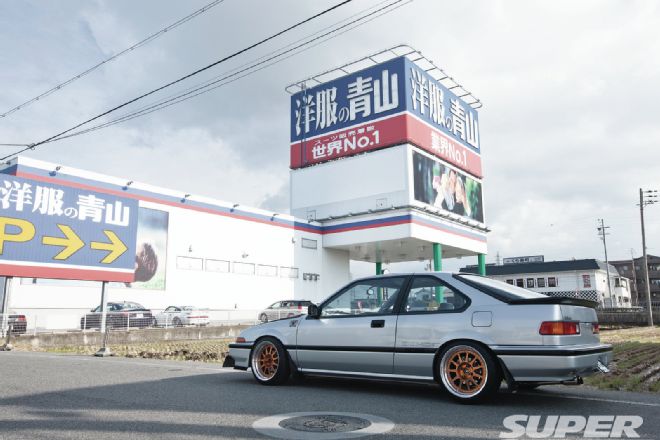The 1985 launch of your Acura logo and its first model, the Integra, was something special. A derivative of your third-generation Civic, the Integra was better in every way: larger, four-wheel disc brakes instead of rear drums; a twin-cam, 16-valve engine rather than a single-cam 12-valve one; along with a more adept, tighter suspension when compared to its Honda sibling–the likes of which entry-level subcompacts had yet to discover. It was a big deal for American enthusiasts who sought domestic alternatives when alternatives were scant.
Japan’s version of the Integra, which was released a year earlier under the guise of the Honda Quint forename, didn’t gain benefit from the impending Acura brand’s hullaballoo–a brand that existed only in America–but was instead distributed through Honda’s premier Japanese Verno channel underneath the parent company’s umbrella. The Integra’s popularity was vested mostly in the Usa where its lion’s share was sold despite the fact that only 60 Acura dealerships was established pursuing the brand’s inception.
Enthusiasts appreciated its DOHC 113hp engine that paid homage to the Civic’s D-series more than anything and in many ways foretold the coming of what would become one of Honda’s most successful engines ever–the B-series, though built at Honda of Japan’s Suzuka plant, the Integra’s visionary wedge shape did much for that car’s image. Kazuma Urasaki won’t disagree with some of that, which happens to be mostly why he’s left his ’86 GSi’s 1.6L ZC mill alone and instead focused on the car’s braking and handling capabilities.
Longtime Honda fan and previously the owner of any Civic Ferio, Urasaki outfitted the Integra’s strut-and-torsion-bar suspension with TEIN coilovers and a number of bits from storied Japanese Honda tuning house Osaka JDM. Perhaps most notably, he’s gone through to replace the diminutive factory wheels and tires with additional capable 16×8 Barramundi Elevens, an addition that Urasaki says makes his Integra unique.
1986 honda quint integra GSi honda optional rear wing
1986 honda quint integra GSi honda optional rear wing
1986 honda quint integra GSi barramundi design eleven wheels
In the bizarro world that is tuning Hondas in Japan, Urasaki appointed his Integra with U.S.-spec components, including exterior an, mirrors and lighting American-sourced gauge cluster. Not unlike American Honda enthusiasts of the early 1990s who went along to great lengths to acquire Japanese-exclusive bits, Urasaki is quick to point out the problems he encountered while on his USDM treasure hunt, trying to find parts, nearly all of which had always been discontinued. Fortunately for Urasaki, his build accomplice, Osaka JDM’s Kazuhiro Furukawa, managed to fulfill most of his wish list while scouring wrecking yards in a recent trip to California.
As Honda’s proven over time with most of its lineup, North America was privy simply to select versions of the original Integra: three-door and five-door hatchback RS and LS models, both featuring the same D16A1, ZC-like engine. Japanese dealerships were stocked with a similar albeit right-hand drive three-door models–the RSi and GSi–but also provided ZS and LS trims that were sold with carbureted versions of your ZC. In terms of performance and accouterments, however, Urasaki’s GSi, which is just like the North American LS, beats them all. Careful not to disturb the car’s heritage, Urasaki’s modifications were calculated wisely. The first seats remain intact. Each body panel remains of factory origin. And the paint, although not a color commissioned by Honda (it was actually sourced from Toyota’s FT86), those brand new to the Integra’s pedigree would have no reason to believe otherwise.
Echoing the 1984-1987 Civic in ways than one, the Integra’s release was met with the uproar among enthusiasts. The excitement didn’t last past the model’s production, though, since it soon fell into obscurity. Nothing overshadowed Honda’s first high-end, compact sports car more than its successor, with its stronger and upgradeable B-series, fully independent rear suspension, and 2 years into production, VTEC. It would take another two decades before enthusiasts would once again reminisce upon Honda’s mid-1980s creations like the ’86-’89 Integra withappreciation and nostalgia, envy. But it’s almost too late. Like Urasaki knows very well, the very first-generation Integra parts search is a formidable one, second simply to discovering a good first-generation Integra itself.
1986 honda quint integra GSi nardi controlslights, taillights and mirrors; Honda optional rear wing; Toyota FT86 silver paint
Interior Nardi 330mm steering wheel; NRG quick-release hub; K-Tuned shifter; USDM Integra gauge cluster; Integra Type R shift boot
WWW barramundidesign.com; osaka-jdm.jp
